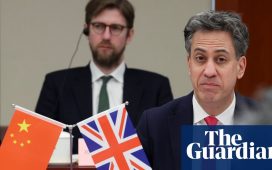I remember the first time wind energy emerged as a serious contender in the UK’s energy provision. It was 6 November 2012, and the country’s electricity use from wind hit an all-time high in the middle of the afternoon, at 9.3%. The casual observer wouldn’t have noticed, and the expert wouldn’t have been surprised, but for people between those poles, it was astonishing. Windfarms were then perceived as a nascent technology, so infant and speculative they needed endless subsidy, intervention, special pleading.
To this day, it remains a mystery how a reputation for well-meant inadequacy clings to renewable energy sources: it can’t all be the result of lobbying by the fossil fuel industry. Sometimes, it feels like we just don’t want good news.
Last week, for two days straight, wind power hit a peak of supplying over half of all the UK’s electricity use. For five months last year, low-carbon electricity sources (solar, wind, hydrogen and nuclear) constituted more than 50% of the country’s energy use. And unbelievably, the National Grid spends hundreds of millions to billions a year constraining energy supplies, that is, paying renewable suppliers when they’re generating too much power for the grid to handle.
It’s one triumph after another in green energy, but you wouldn’t know it to look at our bills, nor to examine our short- and medium-term policy framework. UK energy unit prices are the highest in the world. Without the government price cap intervention, businesses would already be bankrupt, schools probably shut down and people freezing in their homes. Jeremy Hunt’s pledge to withdraw the price cap from next April looks fanciful: sure, the words coming out of his mouth make sense – prices can’t be held down forever because it wouldn’t be “responsible”. But there’s no imaginable reality in which the “unlimited volatility in international gas prices” he refers to can be weathered by the average household.
Meanwhile, research by Nesta, the innovation foundation, has shown that if we meet the offshore wind target set by the government’s energy security strategy – 50GW by 2030 – then on an ideal windy day, that alone would provide almost twice as much energy as we use, before you even factor in onshore and solar. There is a real prospect of limitless cheap energy, some of the time, with windless days covered by, ideally, nuclear as an alternative.

The only brake on this bright future is in storage, grid capacity and interconnectivity. Research and investment are urgently needed into ways to store renewables, as well as viable exchange between us and mainland Europe and the island of Ireland. It is no longer wild to imagine a time when all the weather conditions of the continent can be pooled so that we benefit from one another’s surpluses; and this is before you factor in the development in hydrogen, which is hoped to provide 10GW by 2030. Green energy insiders liken it to the vaccine quest: these things take a decade when you give them a decade. Greater urgency sharpens the senses, and can accelerate the most arduous discovery process to a fraction of that.
The ramifications of this abundance are immense. The promise of going into the 2030s with net zero assured reshapes every sector, every ambition. Then there are the immediate, concrete impacts: households and businesses that can afford their bills; geopolitics no longer held hostage by oil and gas-rich autocrats.
So the question is, how have we allowed a sense of hardship and doom to define our energy debate, when we’re on the brink of an entirely new future? We’re partly suffering from collapsing faith in institutions and government. It’s genuinely hard to imagine constructive, farsighted decisions coming out of an administration whose core priority is stamping out wokery in higher education. Perhaps even suggesting limitless cheap energy sounds woke to Rishi Sunak.
Yet the more proximal cause of our malaise is that the advances in renewables aren’t reflected in our energy prices, which are set by the gas price. A UCL report noted that fossil fuels set the electricity price most of the time, at levels that are now much higher than the green sources that constitute at least half of the load: so renewables can get ever cheaper and more efficient, and we won’t feel it in our bills. Energy markets must be broken up into clean power and fossil power.
Finally, there is a drumbeat of despair that even when inflation has subsided, even after the war in Ukraine comes to an end, high energy prices are here to stay. Oil and gas companies, bemoaning the windfall taxes and green investments required of them, predict prices that are elevated, if less volatile, for ever. “We need to treat energy as something that is not abundant,” said Anders Opedal, chief executive of Norway’s state oil producer, Equinor, this week.
The cynicism is jaw-dropping: the fossil fuel industry situates its problems in the green investments that are, in fact, our only salvation. And Conservative politicians and commentators parrot them, through some combination of lobbying and lack of imagination which would be unedifying to pick apart. We will not grasp the scale and plenty of the green revolution until we treat vested interests who naysay it with the scepticism they deserve: and we need to grasp it, if we’re going to make it happen.











